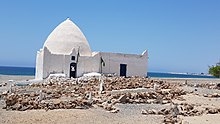Sheikh Ishaq الشيخ إسحاق | |
|---|---|
 Tomb of Sheikh Ishaaq in Maydh, Sanaag, Somaliland | |
| Personal life | |
| Died | 12th century Maydh, modern-day Somaliland |
| Children | Ahmed (Tolje'lo) Musa (Je'lo) Muhammad ('Ibran) Ibrahim (Sanbuur) Abd al-Rahman (Awal) Muhammad (Arap) Ayub Isma'il (Garhajis) |
| Region | Somaliland, Ethiopia, Djibouti |
| Main interest(s) | Islamic literature, Islamic philosophy |
| Other names | Ash-Shaykh Ishaaq |
| Religious life | |
| Religion | Islam |
| Jurisprudence | Shafi’i school |
Ishaaq bin Ahmad bin Muhammad , more commonly known as Sheikh Ishaaq or Sheikh Isaaq (Arabic: الشيخ إسحاق بن أحمد بن محمد, romanized: Ash-Shaykh Isḥāq bin Aḥmad bin Muḥammad, Somali: Sheikh Isxaaq) is a prominent figure in the oral traditions of the Somali Isaaq clan-family. According to these traditions, which were also preserved in several Arabic hagiologies,[1] he was an Islamic scholar of the Shafi’i school who crossed the sea from Arabia to the Horn of Africa. He is traditionally regarded as the Sayyid forefather of the Isaaq clan-family, whose territory in the Horn of Africa is wide and densely populated.[2][3][4][5]
According to tradition, Sheikh Ishaaq traveled from Arabia to Somaliland in the 10th or 11th century, where he married two women; one from the local Dir clan and the other from the neighbouring Harari people.[6][7][8] He sired eight sons who are the common ancestors of the Isaaq clan-family. He remained in Maydh until his death.[9] He is said to have settled in what is today the Erigavo District, and to have established his capital at Maydh.[10]
The stories surrounding Sheikh Ishaaq have played an important role in establishing and reinforcing the Arab and Muslim identity of the Isaaq clan.[11] Scholar Christopher Ehret considers the founders of Somali clans like the Isaaq and the Darod to have been historical figures, but he regards the accounts surrounding them as legends.[12] While Sada Mire regards the foundation of Somali clan lineages by Arab progenitors as part of "the Somali Islamic myth of origin",[13] she does relate the legendary accounts surrounding them to historical migrations from South Arabia to Somalia.[14]
Biography
As a figure known only from oral tradition and hagiological accounts,[15] Ishaaq bin Ahmed's historicity is unclear, and there are varying views on the validity of the narratives about him. Christopher Ehret considers the founders of Somali clans like the Isaaq or the Darod to have been historical figures, but regards the accounts surrounding them as legends.[12] Mohamed Haji Mukhtar expresses skepticism that the population of two of the largest Somali clans (Isaaq and Darod) could descend from two Arab individuals (Ishaaq bin Ahmed and Abdirahman bin Isma'il al-Jabarti, respectively).[16] The pan-Islamic scholar Sharif Aydarous considers the accounts to be largely historical.[17]
Early life
According to tradition, after the death of Sheikh Ishaaq's grandfather he went on a series of migrations in order to study further and preach Islam. He first preached in Mecca and then travelled to Egypt, and hence to Eritrea and Zeila.[7] He then later settled in the area of Saba' in modern-day Yemen where he married the sister of the king of the Al Haqar clan.[18][19] Sheikh Ishaaq later settled in the Al-Jawf region in northern Yemen where he married once again and had a son, Mansur, who is the forefather of the Al Mansur clan in the Al-Jawf region. He then travelled to Yaba where he married and had a son, Yusuf, who is the forefather of the Al Yusuf clan based in Yaba and Ma'rib regions.[20][18][21]
Migrations
Traditional Arabic hagiologies of the Isaaq clan describe how Sheikh Isaaq first made a series of travels through Arabia, before sailing to the ancient Somali port of Zeila and continuing his travels through Somaliland and some regions of Ethiopia, finally settling in Maydh.[11]
While scholar Ioan Lewis considers these travel accounts to be a foundation myth, he does acknowledge that they likely reflect a historical settlement of Arabs in Somaliland.[11] Scholar Sada Mire also regards the narratives surrounding the founders of Somali clan lineages like Ishaaq bin Ahmed to be part of origin myths. In her view, these origin myths are meant to establish, through the link created between modern Somali clans and early Islamic figures like the prophet Muhammad or Ali ibn Abi Talib, a notion of 'divine kinship'.[22] Mire also notes that while the Somali clan members she interviewed stated that Ishaaq bin Ahmed arrived in Somalia about "850 years ago", historical records indicate that migrations from Hadhramaut and other parts of South Arabia to Somalia did take place c. 1250.[14]
Arrival in the Horn of Africa
In accordance with tradition, Sheikh Ishaaq then continued his journey and migrated to Zeila, Somaliland and finally Harar in Ethiopia.[21] Several accounts indicate Shaykh Yusuf al Kownayn and Sheikh Isaaq were known to be contemporaries in Zeila and in contact at the same time.[23][24][25] According to a popular legend, Shaykh Yusuf al Kownayn, known locally as Aw-Barkhadle, upon meeting Sheikh Ishaaq prophesied that Sheikh Ishaaq would be blessed by Allah with many children while Shaykh Yusuf would not have descendants. According to the prophecy the descendants of Sheikh Ishaaq would also visit Aw-Barkhadle's grave and pay respect and perform siyaaro, or pilgrimage to his tomb.[26] Saints and Somalis: popular Islam in a clan-based society states:
Since, however, Aw Barkhadle’s precise connection with the rulers of Ifat is not widely known, he appears as an isolated figure, and in comparison with the million or so spears of the Isaaq lineage, a saint deprived of known issue. The striking difference between these two saints is explained in a popular legend, according to which, when Sheikh Isaaq and Aw Barkhadle met, the latter prophesied that Isaaq would be blessed by God with many children. He, however, would not have descendants, but Isaaq’s issue would pay him respect and siyaaro (voluntary offerings). So it is, one is told, that every year the Isaaq clansmen gather at Aw Barkhadle’s shrine to make offerings in his name.[27]
According to tradition, after studying and proselytizing in Harar he then undertook the pilgrimage to Makkah, came back to Somaliland and went along the shore eastward to the coastal town of Maydh in eastern Somaliland, where he converted the pagan peoples to Islam.[7] He later settled in the town aged 60,[28] where he married two women; one of the Magaadle Dir clan called Magaado, and a Harari woman called Hanifa, the daughter of a Harari emir, with descendants belonging to the Habar Magaadle or Habar Habusheed branches respectively.[7][8] He sired eight sons who are the common ancestors of the subclans of the Isaaq ethnic group. He remained in Maydh until his death.[29][30]
Lineage
Most Arabic hagiologies are in agreement when it comes to the lineage of Sheikh Ishaaq, tracing his lineage to Ali bin Abi Talib, the cousin and son-in-law of the Islamic prophet Muhammad.[31]
There are 2 claimed lineages attributed to Sheikh Ishaaq by two Arabic hagiologies, both of which are covered by Alessandro Gori in Studi sulla letteratura agiografica islamica somala in lingua araba.[31] The first lineage is as follows:
Ash-Shaykh Ishaq bin Ahmad bin Muhammad bin Husayn bin Ali bin Muhammad bin Hamza al-Muttahar bin Abdallah bin Ayyub bin Qasim bin Ahmad bin Ali bin Isa bin Yahya bin Ja’far bin Ali al-Hadi bin Muhammad al-Jawad bin Ali al-Ridha bin Musa al-Kadhim bin Ja'far al-Sadiq bin Muhammad al-Baqir bin Zayn Al-Abidin bin Husayn bin Ali bin Abu Talib bin Abdel Muttalib bin Hashim bin Abdel Manaf bin Qusayy bin Kilab bin Murrah bin Ka’ab bin Lu’ayy bin Ghalib bin Quraysh bin Malik bin Al-Nader bin Kinanah bin Khouzayma bin Mudrikah bin Ilyas bin Mudhar bin Nizar bin Ma’add bin Adnan.[31]
The second lineage reported by Gori is as follows:
Sheikh Ishaq bin Ahmed bin Mohammed bin Hussein bin Ali Mohammed bin Hamza Al-Mutahir bin Abdullah bin Ayoub bin Qassim bin Ahmed bin Ali bin Isa bin Yahya bin Mohammed Al-Taqqi bin Hassan Al-Askari bin Ali Al-Hadi bin Mohammed Al-Jawad bin Ali Al-Reza bin Musa Al-Kadhim bin Jaafar Al-Sadiq bin Mohammed Al-Baqer bin Ali Zain Al-Abideen bin Hussein bin Ali bin Abi Talib[31]
Scholar Ioan Lewis considers that, given the preponderance of names belonging to early Islamic Arabia rather than to medieval Somali-Arab culture, these lineages are unlikely to be genuine.[11] According to Lewis, the genealogy is 'Arabicized' with the goal of enhancing the prestige of the Isaaq among the many ethnic groups in modern and contemporary Somalia.[11] Scholar Sada Mire regards the creation of lineages like this as part of what she terms "the Somali Islamic myth of origin".[13] The pan-Islamic scholar Sharif Aydarous considers the accounts to be largely historical, and agrees with the tradition of Ishaaq bin Ahmed's Arab origin.[17]
Descendants

In the Isaaq ethnic group are divided into two uterine divisions, as shown in the genealogy. The first division is between those lineages descended from sons of Sheikh Ishaaq by a Harari woman – the Habr Habusheed – and those descended from sons of Sheikh Ishaaq by a Somali woman of the Magaadle sub-clan of the Dir – the Habr Magaadle. Indeed, most of the largest clans of the Isaaq ethnic group are in fact uterine alliances hence the matronymic "Habr" which in archaic Somali means "mother".[32] This is illustrated in the following ethnic structure.[33]

A. Habr Magaadle
B. Habr Habuusheed
- Ahmed (Tol Je’lo)
- Muuse (Habr Je'lo)
- Ibrahiim (Sanbuur)
- Muhammad (‘Ibraan)

There is clear agreement on the clan and sub-clan structures that has not changed for a long time. The oldest recorded genealogy of a Somali in Western literature was by Sir Richard Burton in the mid–19th century regarding his Isaaq (Habr Yunis) host and the governor of Zeila, Sharmarke Ali Saleh.[34]
The following listing is taken from the World Bank's Conflict in Somaliland: Drivers and Dynamics from 2005 and the United Kingdom's Home Office publication, Somaliland Assessment 2001.[35][36]
- Isaaq
- Habr Awal
- Arap
- Ayub
- Garhajis
- Habr Je'lo
- Muuse Abokor
- Mohamed Abokor
- Samane Abokor
- Tol Je'lo
- Sanbuur
- Imraan
One tradition maintains that Sheikh Ishaaq had twin sons: Muhammad (Arap), and Ismail (Garhajis).[37] In addition, Sheikh Ishaaq had four additional sons in Yemen (Dir'an, Shareef, Yusuf and Mansur) whose descendants inhabit parts of northern Yemen, including the Khawlan district and the Ma'rib governorate.[21][38][20][39]
In one account, Sheikh Ishaaq's three eldest sons split their father's inheritance among themselves.[40] Isma’il receives his imama, a symbol of leadership; Abdel-Rahman receives the sheikh's wealth; and Ahmad inherits his sword.[40] The story is intended to depict the Garhajis' alleged proclivity for politics, the Habr Awal's mercantile prowess, and the Habr Je'lo's bellicosity.[40]
To strengthen these tribal stereotypes, historical anecdotes have been used: The Habar Yonis allegedly dominated positions as interpreters for the British during the colonial period, and thus acquired pretensions to intellectual and political superiority; Habr Awal dominance of the trade via Djibouti and Berbera is practically uncontested; and Habr Je’lo military prowess is cited in accounts of previous conflicts.[40]
Legacy
There are a number of existing hagiologies in Arabic which describe Sheikh Ishaaq's travels, works and life in Somaliland, as well as his movements in Arabia before his arrival.[41] Like other texts of this genre, they are strongly focused on narrating the holy man's pious deeds and the miracles he performed. Among these texts are:
- Manāqib al-shaykh Isḥāq (a text in the genre of manaqib or 'laudatory biography')[15]
- Nubdha ('genealogical account'), written by Ādam ibn Waʿays[15]
- Amjād ('praiseworthy qualities'), written by Ḥusayn ibn Aḥmad Darwīsh[15]
Sheikh Ishaaq's descendants would later go on to form two powerful sultanates that dominated the northern coastline of the Horn of Africa during the early modern era; the Isaaq sultanate and the Habr Yunis sultanate.[42][43][44]
Tomb
Sheikh Ishaaq's tomb is in Maydh, and is the scene of frequent pilgrimages.[41] Sheikh Ishaaq's mawlid (birthday) is also celebrated every Thursday with a public reading of his manaaqib (a collection of glorious deeds).[8] His siyaara or pilgrimage is performed annually both within Somaliland and in the diaspora particularly in the Middle East among Isaaq expatriates.[45] The tomb was kept by the family of Somali artist Abdullahi Qarshe.[46]
Murray in his book The Journal of the Royal Geographical Society notes that many men from the western Isaaq clans would travel to Maydh to spend the last years of their lives in hopes of being buried near Sheikh Ishaaq.[47] The book states:[47]
The stranger is at once struck with the magnitude of the burial-ground at Meyet, which extends for fully a mile each way. Attachment to the memory of their forefather Isaakh yet induces many aged men of the western tribes to pass the close of their lives at Meyet, in order that their tombs may be found near that of their chief, and this will account for the unusual size of this cemetery. Many of the graves have head-stones of madrepore, on which is cut in relief the name of the tenant below, and of these many are to be found 250 years old.
References
- ^ Drozdík 2005. Some of these were published by Gori 2003.
- ^ Ethnic Groups (Map). Somalia Summary Map. Central Intelligence Agency. 2002. Retrieved 2012-07-30. Perry–Castañeda Library Map Collection – N.B. Various authorities indicate that the Isaaq is among the largest east African clans who adopted the somali language [1], [2].
- ^ "Somalia – The great Somali migrations". Encyclopedia Britannica. Retrieved 2021-03-24.
- ^ Berns-McGown, Rima (1999). Muslims in the Diaspora: The Somali Communities of London and Toronto. Toronto: University of Toronto Press. pp. 27–28. ISBN 9780802082817.
- ^ Lewis, Ioan M., A Modern History of the Somali, fourth edition (Oxford: James Currey, 2002), pp. 22–23.
- ^ Nelson, Harold D. (1982). Somalia, a Country Study. U.S. Government Printing Office. p. 330.
- ^ a b c d Dierk Lange Ancient Kingdoms Of West Africa 1.
- ^ a b c I.M. Lewis, A Modern History of the Somali, fourth edition (Oxford: James Currey, 2002), pp. 31 & 42
- ^ Adam, Hussein M. (1980). Somalia and the World: Proceedings of the International Symposium Held in Mogadishu on the Tenth Anniversary of the Somali Revolution, October 15–21, 1979. Halgan.
- ^ Lewis, Ioan (1960). "The Somali Conquest of the Horn of Africa". Journal of African History. 1 (2): 213–230. doi:10.1017/S0021853700001808. JSTOR 180241. S2CID 162301641. p. 219.
- ^ a b c d e Lewis, Ioan M. (1994). Blood and Bone: The Call of Kinship in Somali Society. Lawrencewill, NJ: The Red Sea Press. pp. 103–104. ISBN 0-932415-93-8.
- ^ a b Ehret, Christopher (1995). "The Eastern Horn of Africa, 1000 B.C. to 1400 A.D.: The Historical Roots". In Ahmed, Ali Jimale (ed.). The Invention of Somalia. Lawrenceville, NJ: Red Sea Press. pp. 233–256. ISBN 978-0-932415-99-8. p. 251.
- ^ a b Mire 2020, pp. 201, 205–206, cf. pp. 70–71, 154–155.
- ^ a b Mire 2020, p. 63.
- ^ a b c d Drozdík, Ladislav (2005). "Gori, Alessandro: St udi sulla letteratura agiografica islamica somala in lingua araba (Studies in Somalian Hagiographie Islamic Literature in the Arabic Language). Firenze, Universita di Firenze 2003. xii+ 430 pp. ISBN 88-901340-0-3; ISSN 1724-8213" (PDF). Asian and African Studies. 14 (1): 110.
- ^ Mukhtar, Mohamed Haji (1995). "Islam in Somali History: Fact and Fiction". In Ahmed, Ali Jimale (ed.). The Invention of Somalia. Lawrenceville, NJ: Red Sea Press. pp. 1–27. ISBN 978-0-932415-99-8. p. 15.
- ^ a b Sharif Aydarous al-Nadheeri (1955). بغية الآمال في تاريخ الصومال [The Attainment of Hopes regarding the History of Somalia] (in Arabic).
- ^ a b نور, مكتبة. "تحميل كتاب تحفة المشتاق لنسب السيد إسحاق لعبدالرحمن دبة pdf". www.noor-book.com (in Arabic). Retrieved 2021-08-08.
- ^ "Reer Shiekh Isaxaaq". Hoyga Qabaayilka Reer Sheekh Isaxaaq. Archived from the original on 2021-11-09. Retrieved 2021-08-09.
- ^ a b Zaylaʻī, ʻAbd al-Raḥmān Shaykh Maḥmūd; زيلعي، عبد الرحمن شيخ محمود. (2018). al-Ṣūmāl ʻurūbatuhā wa-ḥaḍāratuhā al-Islāmīyah = Somalia's Arabism and Islamic civilization (al-Ṭabʻah al-ūlá ed.). Dubayy. ISBN 978-9948-39-903-2. OCLC 1100055464.
{{cite book}}: CS1 maint: location missing publisher (link) - ^ a b c الاسحاقي الصومالي, عبدالرحمن. كتاب تحفة المشتاق لنسب السيد اسحاق.
- ^ Mire, Sada (2020). Divine Fertility: The Continuity in Transformation of an Ideology of Sacred Kinship in Northeast Africa. UCL Institute of Archaeology Publications. Vol. 69. New York: Routledge. ISBN 978-1-138-36850-7. p. 256.
- ^ Lewis, I. M. (1998). Saints and Somalis: Popular Islam in a Clan-based Society. The Red Sea Press. ISBN 9781569021033.
- ^ Andrzejewski, B. W. (1983-01-01). Islamic Literature of Somalia. African Studies Program, Indiana University. ISBN 9780941934473.
Shaykh Aw Barkhadle and Shaykh Isaaq belonged to the same time period.
- ^ Bader, Christian (2000). Mythes et légendes de la Corne de l'Afrique (in French). Karthala. p. 90. ISBN 9782845860698.
Translated from French to English: Then, at the age of 68 (Shaykh Isaaq), he took his pilgrim's staff and went to Harar, where the Sheikh 'Aw Barkhadle was then teaching.
- ^ Lewis, I. M. (1998). Saints and Somalis: Popular Islam in a Clan-based Society. The Red Sea Press. ISBN 978-1-56902-103-3.
- ^ Lewis, I. M. (1998). Saints and Somalis: popular Islam in a clan-based society. Red Sea Press. p. 94. ISBN 1569021031.
- ^ يحيى, بن نصر الله الهرري. مناقب الشيخ أبادر- متحف الشريف عبد الله في هرر.
- ^ Adam, Hussein M. (1980). Somalia and the World: Proceedings of the International Symposium Held in Mogadishu on the Tenth Anniversary of the Somali Revolution, October 15–21, 1979. Halgan.
- ^ Laurence, Margaret (1970). A Tree for Poverty: Somali Poetry and Prose. Hamilton: McMaster University. ISBN 978-1-55022-177-0.
- ^ a b c d Gori, Alessandro (2003). Studi sulla letteratura agiografica islamica somala in lingua araba. Firenze: Dipartimento di linguistica, Università di Firenze. p. 72. ISBN 88-901340-0-3. OCLC 55104439.
- ^ Lewis, I. M. (1999). A Pastoral Democracy: A Study of Pastoralism and Politics Among the Northern Somali of the Horn of Africa. LIT Verlag Münster. ISBN 9783825830847.
- ^ I. M. Lewis, A pastoral democracy: a study of pastoralism and politics among the Northern Somali of the Horn of Africa, (LIT Verlag Münster: 1999), p. 157.
- ^ Burton. F., Richard (1856). First Footsteps in East Africa. p. 18.
- ^ Worldbank, Conflict in Somalia: Drivers and Dynamics, January 2005, Appendix 2, Lineage Charts, p. 55 Figure A-1
- ^ Country Information and Policy Unit, Home Office, Great Britain, Somalia Assessment 2001, Annex B: Somali Clan Structure Archived 16 July 2011 at the Wayback Machine, p. 43
- ^ Laurence, Margaret (1970). A Tree for Poverty: Somali Poetry and Prose. Hamilton: McMaster University. p. 145. ISBN 978-1-55022-177-0.
Then Magado, the wife of Ishaak had only two children, baby twin sons, and their names were Ahmed, nick-named Arap, and Ismail, nick-named Garaxijis .
- ^ MENAFN. "History of Sheikh Isaaq bin Mohammed (Al-Hashimi)". menafn.com. Retrieved 2021-08-07.
- ^ الغرباني, محمد بن أحمد. صورة لمخطوطة الغرباني التي تتحدث عن سيرة وحياة الشريف إسحاق بن أحمد الرضوي. pp. 95–96.
- ^ a b c d Dr. Ahmed Yusuf Farah, Matt Bryden. "Case Study of a Grassroots Peace Making Initiative". www.africa.upenn.edu. UNDP Emergencies Unit for Ethiopia. Retrieved 2022-01-03.
- ^ a b Roland Anthony Oliver, J. D. Fage, Journal of African history, Volume 3 (Cambridge University Press.: 1962), p.45
- ^ "Taariikhda Beerta Suldaan Cabdilaahi ee Hargeysa | Somalidiasporanews.com". Retrieved 2021-01-09.
- ^ Genealogies of the Somal. Eyre and Spottiswoode (London). 1896.
- ^ "Taariikhda Saldanada Reer Guuleed Ee Somaliland.Abwaan:Ibraahim-rashiid Cismaan Guure (aboor). | Togdheer News Network". Archived from the original on 2021-01-11. Retrieved 2021-08-09.
- ^ Reese, Scott S. (2018). "Claims to Community". Claims to Community: Mosques, Cemeteries and the Universe. Islam, Community and Authority in the Indian Ocean, 1839–1937. Edinburgh University Press. p. 69. ISBN 978-0-7486-9765-6. JSTOR 10.3366/j.ctt1tqxt7c.10. Retrieved 2022-01-03.
{{cite book}}:|work=ignored (help) - ^ Hassan, Mohamed-Rashid (2008-11-04). "Interview with the late Abdullahi Qarshe (1994) at the Residence of Obliqe Carton in Djibouti". Bildhaan. 2 (1): 65. ISSN 1528-6258.
- ^ a b Society, Royal Geographical (1849). The Journal of the Royal Geographical Society: JRGS. Murray. p. 64.








